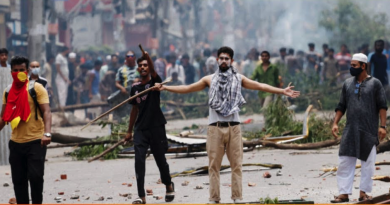Timeline: U.S.-Iran relations from 1953 coup to 2020 commander killing
Washington (Reuters) – Iran promised harsh revenge after a U.S. air strike in Baghdad on Friday killed Qassem Soleimani, commander of Iran’s elite Quds Force and architect of its growing military influence in the Middle East.
The U.S. said the strike was aimed at disrupting an “imminent attack” that would endanger Americans in the Middle East.
Following is a chronology of major events in relations between the Iran and the United States:
1953 – The CIA helps orchestrate overthrow of Iran’s popular Prime Minister Mohammed Mossadegh, restoring to power Shah Mohammed Reza Pahlavi.
1957 – The United States and Iran sign an agreement on civil nuclear cooperation.
1967 – The United States provides Iran with a nuclear reactor along with weapons-grade 93 percent enriched uranium fuel.
1968 – Iran signs the Nuclear Non-Proliferation Treaty which permits it to have a civil nuclear program in return for a commitment not to acquire nuclear weapons.
1979 – Iran’s Islamic Revolution forces U.S.-backed shah to flee, Ayatollah Ruhollah Khomeini returns from exile and becomes supreme religious guide. Fundamentalist students seize the U.S. Embassy in Tehran and hold staff hostage.
1980 – The United States cuts diplomatic ties with Iran, seizes Iranian assets and bans most trade with it; hostage rescue mission ordered by President Jimmy Carter fails.
1981 – Iran releases 52 U.S. hostages minutes after Carter steps down and Ronald Reagan is inaugurated as U.S. president.
1984 – U.S. lists Iran as a state sponsor of terrorism.
1986 – Reagan reveals secret arms deal with Tehran in violation of U.S. arms embargo.
1988 – U.S. warship Vincennes mistakenly shoots down Iranian passenger plane over the Gulf, killing all 290 aboard.
2002 – President George W. Bush declares Iran, Iraq, North Korea an “axis of evil.” U.S. officials accuse Tehran of operating secret nuclear weapons program.
2006 – Washington says willing to join multilateral nuclear talks with Iran if it verifiably suspends nuclear enrichment.
2008 – Bush for the first time sends an official to directly take part in nuclear negotiations with Iran in Geneva.
2009 – President Barack Obama tells Iran’s leaders he would extend a hand if they would “unclench their fist.”
2009 – Britain, France and the United States announce that Iran is building a secret uranium-enrichment site at Fordow.
2012 – U.S. law gives Obama the power to sanction foreign banks if they fail to significantly reduce their imports of Iranian oil. Iranian oil sales drop, sparking an economic downturn.
U.S. and Iranian officials begin secret talks, which intensify in 2013, on the nuclear issue.
2013 – Hassan Rouhani is elected Iran’s president on platform of improving Iran’s relations with the world and its economy.
In September, Obama and Rouhani speak by telephone, the highest-level contact between the two countries in three decades.
In November, Iran and six major powers reach agree to the Joint Plan of Action nuclear deal. Iran agrees to curb its nuclear work in return for limited sanctions relief.
2016 – Iran releases 10 U.S. sailors who ended up in Iranian territorial waters; the United States and Iran conduct a prisoner swap.
2018 – U.S. President Donald Trump withdraws from the nuclear deal in May, and reimposes crippling economic sanctions on Iran.
2019 – The U.S. designates the Islamic Revolutionary Guard Corps a “terrorist organization” in April.
Iran says in May it will increase enriched uranium production, bucking its commitments under the nuclear accord.
Oil tankers are attacked in the Gulf in May and June. The United States blames Iran, a charge Tehran denies.
Iran shoots down an U.S. drone in June it says was in Iranian airspace, and seizes a British oil tanker in July.
Saudi Arabia’s state-run oil company is attacked in September by drones and missiles believed to be from Iran; Tehran denies involvement.
In December, attacks on U.S. military bases in Iraq kill a U.S. citizen. The United States blames an Iranian-backed militia inside Iraq, and fires on its bases in retaliation.
Iranian-backed militias protest outside the U.S. Embassy in Baghdad, storming the security post.



